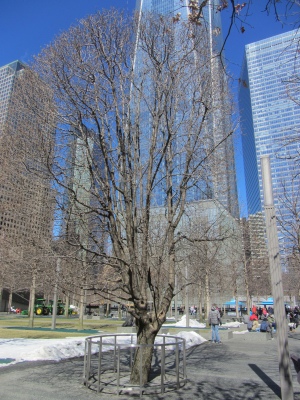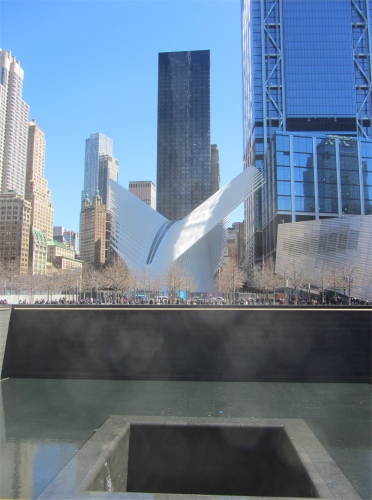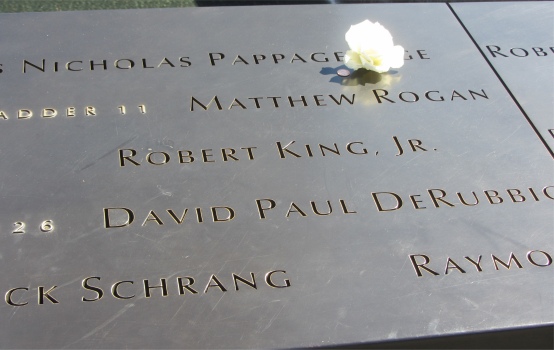
White Rose for a Birthdate
|
The plaza we were standing on with its grove of trees was actually a green roof for the structure housing the 9/11 Memorial Museum, a transportation hub and other facilities 70 feet below street level, an impressive piece of architecture. Within the plaza lay the Memorial's twin reflecting pools, each nearly an acre in size, sitting within the footprints where the Twin Towers once stood. Each pool contained a 30 feet wall down which the largest manmade waterfalls in North America cascaded as a series of tiny rivulets, one for every person who lost their lives. In the centre of each pool, yet another cascading waterfall dropped away into a void. Around the perimeter of each of the twin pools, a continuous thick bronze panel of edging stretched, in which was inscribed the names of every person who died in the 2001 and 1993 attacks, a powerful reminder of the largest loss of life resulting from a foreign attack on American soil and the greatest single loss of rescue personnel in American history.
White roses could be seen in a few of the inscribed names. These were placed on the birthdates of that particular deceased person. People were visibly moved standing around these cascades, staring down into the empty darkness of the voids, and looking up into the empty space where the steel, concrete and glass structures containing a throng of humanity had once occupied it. It moved me to tears.

Freedom Tower,
One World Trade Centre
|
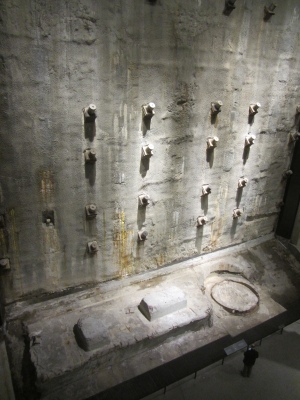
Section of Slurry Wall
|
New towers now exist around the 9/11 memorial. The one that stands out the most is One World Trade Centre, also known as Freedom Tower. After the attacks on 11th September, it took more than a year and a half to clean up the remaining steel and concrete that was left when the buildings collapsed. After everything was cleared away, the first round of the design competition was held for a whole new World Trade Centre complex. The Polish born American Daniel Libeskind won the competition. The World Trade Centre complex is comprised of six buildings, and not just the One World Trade Centre. Libeskind designed the World Trade Centre complex in the shape of a spiral, which ends with the footprints of the Twin Towers, where the 9/11 Memorial now stands.
One World Trade Centre is the tallest building in New York, indeed the tallest skyscraper in the Western Hemisphere. With its reflecting windows and tall antenna, the skyscraper reaches 1,776 feet into the air. The observant reader will no doubt be aware that the height bears a strong resemblance to the year when America gained its independence.
The woman explained that trying to find people trapped was a harrowing experience, involving scratching away through dust and rubble trying to locate cavities and air pockets where people could survive. Although some people were found alive, many were never found. Families who had lost loved ones had no bodies to bury, no way of bringing a sense of closure to their individual tragedies. DNA techniques were coming to the fore at the time. The authorities started to forward body parts of loved ones to families, recognised from DNA traces: part of an ankle, a knuckle, a fragment of skull. After receiving ten or so body parts, people would break down and request, "Please, no more." The pain was too much for them to bear.
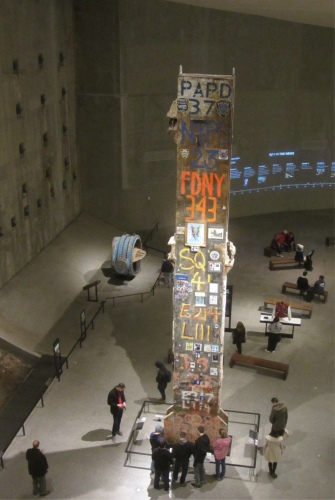
Last Column
|
As time has moved on, there have been even more fatalities. The authorities failed to inform rescuers and clean-up operatives of the dangers to health the dust would inflict upon their lungs. Folk are still dying.
The woman then gave her harrowing tale of the events of the day, and how they had affected her and her family. She had gone to work at an office by the Twin Towers that day, and her husband, a fireman, was on duty too. For some reason, her daughter was not a school that day. After the air strikes, the woman had fled from her place of work to escape the debris that was crashing down. Meanwhile, her daughter was watching all this unfold on TV, and immediately feared the worst for her parents. Communications were down, and the lady managed to make her way home, a remarkable feat considering transport in New York was at a standstill, indeed completely forbidden later. Mother and daughter, now in arms together, were on tenterhooks worrying about husband/dad, a fireman now caught up in all the aftermath. Reports of countless firemen and police officers being lost were sweeping across the media, and the anguish was unbearable for the women. To cut a long story short, he did turn up 36 hours later. It was a raw, emotional tale she related, and she was close to tears at times, as were some of the women in our group. The chap who was silently accompanying her through the tour spoke a few words. He had been a first responder at the time, and was now suffering the effects of lung damage.
And on that sad note, we all parted company.

Foundations of the Twin Towers
|
At one side of the plaza stood a steel and glass building, the National 11th September Memorial Museum's entry pavilion. Inside stood the Tridents, two 80-foot tall steel columns that once formed part of the exterior facade of the North Tower. Called "trees" by World Trade Centre architect Minoru Yamasaki, 84 trident columns formed the perimeter structure of the first five stories of each of the Twin Towers. This museum serves as the country's principal institution for examining the implications of the events of 9/11, documenting the impact of those events and exploring the continuing significance of 11th September 2001. I had to visit it.
Visitors were guided down a ramp which housed a series of multi-media installations, including photographs of people who directly witnessed the attacks and missing person fliers that appeared in the days following 9/11. A further staircase brought me to the museum's 110,000 square feet of exhibition space located within the archaeological heart of the World Trade Centre site.

Steel Girder Bent Like a Straw
|
At the lowest level was the Foundation Hall, a room of massive scale, with ceilings ranging from 40 to 60 feet and nearly 15,000 square feet of floor space. As the name suggests, this was at the level from which the foundations of the Twin Towers were built up. The floor area was large enough to clearly show the foundations of both towers, the perimeters being clearly visible where the massive box girder vertical supports had been sheared off during the clean-up operation. Below here was bedrock. A portion of the slurry wall, a surviving retaining wall of the original World Trade Centre that withstood the devastation of 9/11. The slurry wall was part of a concrete "bath tub" build around the area where the towers were built in order to hold back the Hudson River during the construction phase. I was amazed at its simple construction. A very deep trench had been excavated, and filled in with a slurry of clay and water to provide support. Steel reinforcing cages were then lowered in, and finally concrete was poured in. Being heavier than the slurry, this simply sank to the bottom forcing the slurry out - ingenious.
Standing close to a section of the slurry wall stood the Last Column. As the recovery of the World Trade Centre neared completion, one piece of steel was chosen to mark the occasion symbolically. Designated the Last Column, it was removed from the site in a solemn ceremony held on 30th May 2002. In the weeks that preceded its departure, recovery workers, first responders, volunteers and victims' relatives signed the column and affixed to it memorial messages, photographs and other tributes.
Between the footprints of the original North and South towers of the World Trade Centre, stood the Memorial Hall. This hall showcased a quote from Virgil's
Aeneid and framed by a blue-tiled artwork. Composed of 2,983 individual tiles, commemorating the victims of 11th September 2001 and 26th February 1993, every square is a unique shade of blue, reflecting artist Spencer Finch's attempt to remember the colour of the sky on the morning of 9/11. The massive artwork is titled
"Trying to Remember the Colour of the Sky on That September Morning". In the centre of the tiled artwork is a quotation,
"No Day Shall Erase You from the Memory of Time", from Book IX of
The Aeneid by the Roman poet Virgil, and suggests the transformative potential of memory. Each of the letters were forged from pieces of recovered World Trade Centre steel by New Mexico blacksmith Tom Joyce.
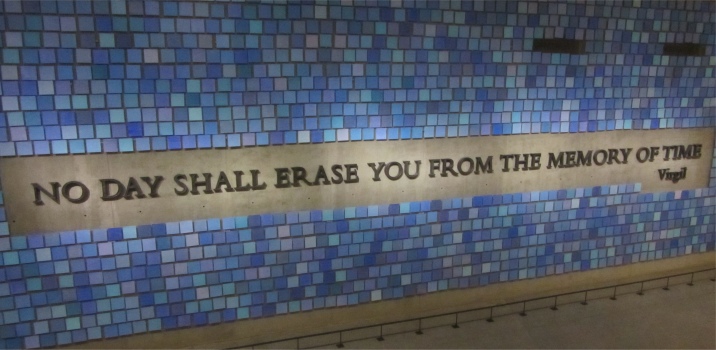
"Trying to Remember the Colour of the Sky on That September Morning" : Spencer Finch
|
An Historical Exhibition in the Memorial Hall's footprint of the North Tower, told the story of 9/11 using artefacts, images, first-person testimony and archival audio and video recordings. It comprised three sequential parts: the Events Before 9/11, of the Day, and After 9/11.
Before 9/11 stepped back in time, providing the historical context leading up to 9/11. It examined the World Trade Centre as a symbol and a target, and addressed the 26th February 1993 World Trade Centre bombing, the evolution of the terrorist network al-Qaeda and the development of the 9/11 plot.
Events of the day presented the day of 11th September 2001 as it unfolded. It provided insight into what was happening on the hijacked airplanes, at the Twin Towers, and at the Pentagon, as well as the courageous actions of first responders and civilians assisting one another, and the experiences of people near and far from the attack sites.
After 9/11 addressed the world after 9/11, presenting a collection of grief and global response. It explored the recovery efforts and rebuilding at the three attack sites through acts of compassion, volunteerism, and public service. It also looked at the questions arising out of 9/11 and the ongoing ramifications, including 9/11-related illnesses and the evolution of national security.
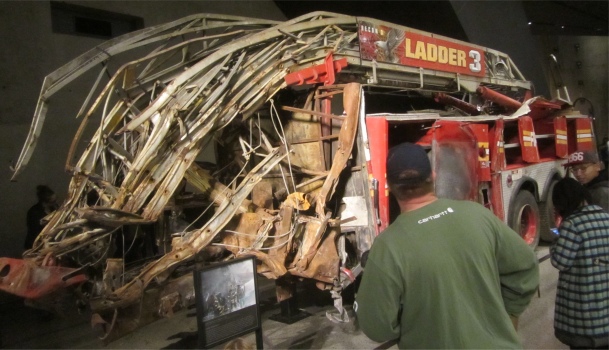
Remains of a Fire Engine
|
A Memorial Exhibition in the Memorial Hall's footprint of the South Tower, housed portrait photographs of the 2,983 victims of both the terrorist acts on the World Trade Centre. Touch-screen tables allowed visitors to learn more about each victim by allowing them to look up individual profiles. Perhaps most haunting was an inner chamber which projected selected individual profiles, including audio remembrances recorded by family members, friends and former colleagues.
On the morning of 11th September, French photographer and video director Stephane Sednaoui witnessed and filmed the events at the World Trade Centre from the roof of his building on Great Jones Street in lower Manhattan. Over the next few days, Sednaoui volunteered in the rescue efforts at what had already come to be called Ground Zero. An exhibition of Sednaoui's photographs drew on an archive of the more than 500 pictures he captured between 12th - 16th September during breaks from the gruelling work of digging through the wreckage.
The monumental artefacts of the Museum provide a link to the events of 9/11, while presenting intimate stories of loss, compassion, reckoning, and recovery that are central to telling the story of the attacks and the aftermath. Exhibits in the Foundation Hall gave a powerful indication of the immense strength of the 9/11 disaster. An aircraft engine, wheel and piece of fuselage that landed blocks away were on display. What amazed me were sections of the large support girders. These were constructed of steel 5cm to 10cm thick, but incredibly they had been bent double during the building collapse as if they were straws. Seeing those, I realised why rescuers ended up searching for body parts.
A truly heart-wrenching piece of video footage was shown in its own separate room, for good reason. It showed people trapped on the buildings with fire raging about them. Desperation set in, and many of those poor people made the mind numbing decision to jump off the building. It was a profound experience watching this, extremely difficult to take in and understand. I must admit I was in tears at times, as were others too.
Most people took their time throughout this museum, there was no casual skipping through. I observed a younger generation totally absorbed, it all being summed up when I caught sight of a young man wiping away his tears.
All in all, I spent six hours on my guided tour and museum visit. It left me emotionally exhausted.
I drifted away up to Bleeker Street where I found Old Tbilisi. I recognised Tbilisi as the capital of Georgia. The last time I was in a Georgian restaurant was on 23rd May 2011 in St Petersburg. I entered and dined on a delicious meal of Borsch followed by Chakhokbili, derived from the word
khokhobi, which means "pheasant" in Georgian, but was really chicken with herbs and tomatoes. The meal was most enjoyable.
45 minutes later I was in the Journal Square Pub. Thursday night was a music night, so I thought it easiest to spend my final night here. The music was provided by "Sweet and Spice", a colourful duo blasting out soul music. The chap played a synthesiser and sang sweet soul, the woman sang even sweeter. They were good musicians, as I have found most musicians in New York to be.
The real stars for me though were the crowd in the bar, an eclectic mix of all age groups. But the older guys in their 50s amazed me. They were thrusting their fists into the air in rhythm to the beat, shouting out the occasional, "Yip!", even getting up and doing their own boogie shuffle as the fancy took them. As they engaged in these activities, some gazed at the musicians, others seemed to stare into space in a world of their own. One chap in his late 40s strutted into the bar, his trouser legs large enough for an elephant, and the crotch below knee level. The African American chap next to me also waved his hands about, and played air guitar and air piano when the mood took him.
Young folk came in, mainly males but there were a few couples. They paid no heed to the cavorting's of the older generation, just twitched in rhythm to beat, drank their cocktails and communicated via their electronic friends.
A young African American woman came in, sat down beside me and ordered a drink. The older African American chap, the air guitarist on the other side of me, shouted across to her. "Hey, mama, you still shooting those dudes at pool?" He obviously knew her. Most of the conversation between them was in a deep New York drawl which was totally lost on me. However, it was obvious he was teasing her, and I could make out she was saying to me, "I don't know what he is talking about." There was much hooting of laughter between them. After she moved on elsewhere, he told me that he once played pool against her. "I had one shot," he laughed in his giggly drawl, "then she had her turn. She would cock her head to one side, give an 'uh-hum', and then point to a pocket and say 'in there'. Then she would pot a ball into that pocket. She completely cleared the table. She has been playing since she was 9 years old, and now she is 28. She goes around the pool halls, playing the innocent and can't play little woman, and then she cleans up. One night she made over $600." He laughed a mighty laugh which collapsed into giggles. Meanwhile the music played on, and the older guys jigged in a fashion worthy of chaps half their age.


